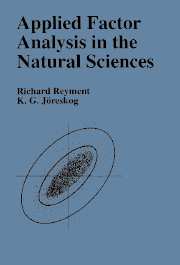Book contents
- Frontmatter
- Contents
- Preface
- Glossary of the most commonly used symbols
- Preface to first edition
- 1 Introduction
- 2 Basic Mathematical and Statistical Concepts
- 3 Aims, Ideas, and Models of Factor Analysis
- 4 R-Mode Methods
- 5 Q-Mode Methods
- 6 Q-R-Mode methods
- 7 Steps in the Analysis
- 8 Examples and Case Histories
- Appendix: Computer programs
- Bibliography
- Index
Preface to first edition
Published online by Cambridge University Press: 12 November 2009
- Frontmatter
- Contents
- Preface
- Glossary of the most commonly used symbols
- Preface to first edition
- 1 Introduction
- 2 Basic Mathematical and Statistical Concepts
- 3 Aims, Ideas, and Models of Factor Analysis
- 4 R-Mode Methods
- 5 Q-Mode Methods
- 6 Q-R-Mode methods
- 7 Steps in the Analysis
- 8 Examples and Case Histories
- Appendix: Computer programs
- Bibliography
- Index
Summary
Our decision to write this book stems from the fact that the kind of analysis involved in what we group under the heading of “Geological Factor Analysis” has become on of the most frequently used sets of multivariate statistical techniques in geology and the general concepts of which many geologists have at least a vague understanding. In putting all of these techniques into the same bag, we recognize the fact that the term “factor analysis” has come to be applied by geologists to a particular kind of analytical procedures of which only a few belong to the classical factor model such as it is conceived by psychometricians.
It is the aim of our text to introduce students of geology to the powerful technique of factor analysis and to provide them with the background necessary in order to be able to undertake analyses on their own. For this reason, we have tended perhaps to be overexplicit when dealing with the introductory requirements for understanding the calculations and to have paid less attention to theoretical details. Clearly, we have definitely not written a text for statisticains.
The analysis of homogeneous multivariate populations in the earth sciences has grown into a primary research branch of almost unlimited potential; this development, largely made possible by the rise of the electronic computer, has greatly altered methodology in the petroleum industry, mining geology, geochemistry, stratigraphy, paleontology, chemical geology, environmental geology, sedimentology, and petrology.
Chapter 1 introduces the concept of multivariate data analysis by factoring methods.
- Type
- Chapter
- Information
- Applied Factor Analysis in the Natural Sciences , pp. xi - xiiPublisher: Cambridge University PressPrint publication year: 1993
- 1
- Cited by

